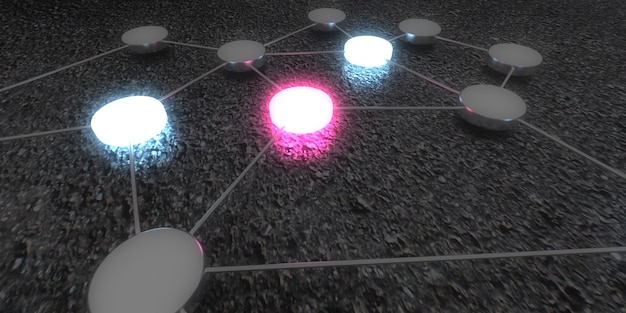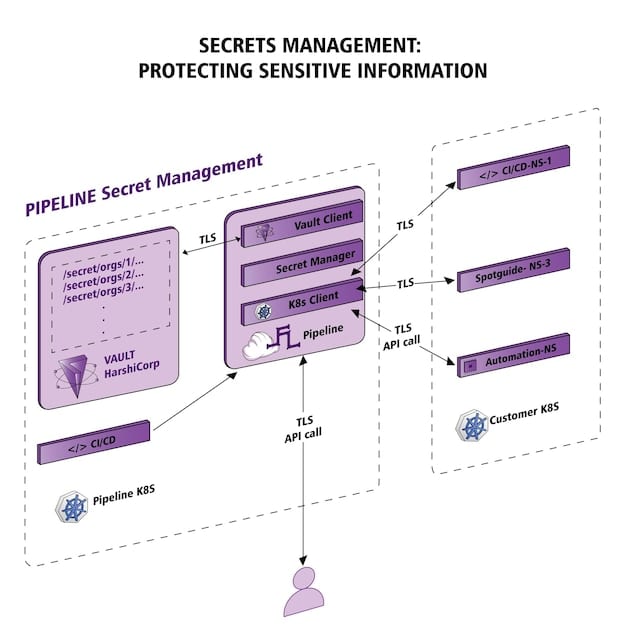Deceptive Tech: Traps to Disrupt APTs in US Networks (40% Dwell Time Cut)

Deceptive technology utilizes decoys and traps to detect, disrupt, and reduce the dwell time of Advanced Persistent Threats (APTs) in US networks by up to 40%, offering a proactive approach to cybersecurity.
In today’s threat landscape, traditional security measures often fall short against sophisticated Advanced Persistent Threats (APTs). Deceptive technology: How to use decoys and traps to detect and disrupt Advanced Persistent Threats (APTs) in US networks, reducing dwell time by 40% offers a powerful alternative by turning the tables on attackers.
Understanding Deceptive Technology and APTs
Deceptive technology is a proactive cybersecurity approach. It involves deploying decoys and traps within a network to lure attackers, providing early detection and valuable intelligence about their tactics.
APTs are stealthy and persistent network attacks. They are often carried out by sophisticated actors with the goal of stealing data or disrupting operations over an extended period.
How Deceptive Technology Works
Deceptive technology works by creating a simulated environment that mimics a real production network. These decoys are designed to attract the attention of attackers, who are then monitored and analyzed.
When an attacker interacts with a decoy, it triggers an alert, providing security teams with early warning of a potential breach. This allows them to take action to contain the threat and prevent further damage.
Deceptive technology provides valuable insights into attacker behavior, allowing security teams to better understand their tactics, techniques, and procedures (TTPs). This information can be used to improve overall security posture.
- Early Detection: Detect threats before they cause significant damage.
- Attacker Profiling: Gain insights into attacker tactics and motives.
- Reduced Dwell Time: Minimize the time attackers spend undetected in the network.
In essence, deceptive technology supplements existing security measures by providing a proactive layer of defense that actively seeks out and engages attackers. It’s about proactively shaping the battlefield rather than simply reacting to attacks.

Benefits of Using Decoys and Traps
Implementing decoys and traps within a network yields various benefits. These benefits extend beyond simply detecting threats to encompass improving overall security and enabling more effective response strategies.
Decoys and traps can be instrumental in reducing the dwell time of APTs. Let’s explore the specific advantages of incorporating these technologies.
Reduced Dwell Time
One of the most significant benefits of using decoys and traps is the substantial reduction in dwell time. Dwell time refers to the period an attacker remains undetected within a network. Traditional security measures often struggle to identify APTs quickly, leading to extended dwell times that can result in severe data breaches and operational disruptions.
By providing early detection, decoys and traps significantly reduce dwell time, minimizing the potential damage caused by an attack. A shorter dwell time means less opportunity for attackers to move laterally, compromise sensitive data, and establish persistent footholds.
Improved Threat Intelligence
Deceptive technology provides valuable insights into attacker behavior, allowing security teams to better understand their tactics, techniques, and procedures (TTPs). This information can be used to improve overall security posture.
When an attacker interacts with a decoy, it triggers an alert, providing security teams with early warning of a potential breach. This allows them to take action to contain the threat and prevent further damage.
- Gather TTPs: Understand how attackers operate within your network.
- Improve Incident Response: Respond more effectively based on real-time intelligence.
- Enhance Security Posture: Proactively address vulnerabilities based on attacker behavior.
Through the analysis of attacker interactions with decoys, security teams can develop a comprehensive understanding of the threat landscape, enabling them to make informed decisions about security investments and strategies.
Decoys and traps provide an additional layer of security that complements existing defense mechanisms, enhancing the overall resilience of the network against advanced threats.
Implementing a Deceptive Technology Strategy
Implementing a deceptive technology strategy requires careful planning and execution. It involves identifying critical assets, deploying appropriate decoys, and integrating the technology with existing security infrastructure.
The goal is to create a realistic and attractive environment for attackers. Let’s explore key steps in deploying deceptive technologies effectively.
Identifying Critical Assets
The first step in implementing a deceptive technology strategy is to identify the critical assets that need to be protected. These assets may include sensitive data, intellectual property, and critical infrastructure components.
Understanding what needs to be protected is essential for determining the type and placement of decoys. Decoys should be strategically positioned near these critical assets to lure attackers away from the real targets.
Deploying Decoys and Traps
Decoys and traps should be deployed in a way that mimics the real production environment. This means using realistic usernames, passwords, and file names. The decoys should also be integrated with the network infrastructure so that they appear to be legitimate resources.
The types of decoys and traps to deploy include:
- Honeypots: Systems designed to mimic production servers, tempting attackers with fake data.
- Decoy Documents: Files designed to lure attackers with the promise of valuable information.
- Network Traps: Fake network shares and services that trigger alerts when accessed.
Integrating deceptive technology with existing security tools, such as SIEM systems and threat intelligence platforms enhances their effectiveness.
Establishing clear incident response procedures is crucial and ensures that security teams are prepared to act swiftly and effectively when an attacker interacts with a decoy.

Reducing Dwell Time by 40%
One of the most compelling benefits of deceptive technology is its ability to significantly reduce the dwell time of APTs. Studies and real-world implementations have shown that organizations using decoys and traps can reduce dwell time by as much as 40%.
This reduction is made possible by:
Early Detection
By providing early warning of a potential breach, deceptive technology allows security teams to take action to contain the threat and prevent further damage. The faster a breach is detected, the less time attackers have to cause harm.
Early detection enables immediate response, limiting the impact of the breach and preventing further compromise of the network.
Attacker Containment
When an attacker interacts with a decoy, it can be quickly isolated and contained, preventing them from moving laterally within the network.
By monitoring attacker activity in real-time, security teams can identify patterns and behaviors that can be used to improve defenses and prevent future attacks.
- Immediate Isolation: Prevent attackers from spreading laterally.
- Real-time Monitoring: Track attacker behavior and tactics.
- Improved Incident Response: Swiftly respond to detected threats.
In practice, this means deploying decoys to mimic the organization’s environment. Continuous monitoring of these decoys allows for rapid detection and response, reducing the overall dwell time.
Case Studies: Deceptive Technology in Action
Several organizations have successfully implemented deceptive technology strategies to detect and disrupt APTs. These case studies provide valuable insights into the real-world effectiveness of decoys and traps.
Let’s examine a few examples of how deceptive technology has been used to protect networks.
Financial Institution
A financial institution deployed a network of honeypots designed to mimic critical infrastructure components. When an APT attempted to access these honeypots, the security team was immediately alerted. The team was able to quickly isolate and contain the attacker, preventing them from accessing sensitive customer data.
Healthcare Provider
A healthcare provider implemented deceptive technology to protect patient data. The provider placed decoy documents containing fake patient records in network shares. When an attacker accessed these documents, the security team was notified. The team was able to track the attacker’s movements and identify the compromised systems.
- Early Detection: Detect attackers before they reach critical assets.
- Real-time Tracking: Monitor attacker activity and identify compromised systems.
- Prevent Data Breaches: Protect sensitive data from theft and exposure.
By deploying deceptive technology, the healthcare provider was able to quickly detect and respond to the attack, preventing a potentially devastating data breach.
The key is proper implementation, integrating the technology properly into the security infrastructure.
Future Trends in Deceptive Technology
The field of deceptive technology is constantly evolving. Future trends include increased use of artificial intelligence (AI) and machine learning (ML) to automate decoy deployment and analysis.
These advancements promise to make deceptive technology even more effective. Let’s consider some key areas of development.
AI-Powered Decoy Deployment
AI and ML can be used to automate the deployment of decoys, making it easier to create a realistic and dynamic environment for attackers. AI-powered systems can analyze network traffic and user behavior to identify the most effective placement for decoys.
Automated deployment streamlines the implementation process. Adaptive decoys change their appearance over time in response to attacker behavior, increasing their effectiveness.
Enhanced Threat Analysis
AI and ML can be used to analyze attacker behavior, providing security teams with more detailed insights into their tactics and motives.
AI-powered threat analysis can also be used to identify patterns and behaviors that can be used to improve defenses and prevent future attacks.
- Behavior Analysis: Gain deeper insights into attacker motives.
- Predictive Defense: Proactively address potential vulnerabilities.
- Automated Response: Streamline incident response workflows.
AI and ML are rapidly transforming deceptive technology, enabling it to become an even more powerful tool for detecting and disrupting APTs. Organizations that embrace these advancements will be better positioned to defend against sophisticated cyber threats.
| Key Point | Brief Description |
|---|---|
| 🛡️ Early Detection | Detect threats before they inflict significant damage on the network. |
| 🕵️ Attacker Profiling | Gain valuable insights into attacker tactics, motives, and behaviors. |
| ⏱️ Reduced Dwell Time | Minimize the time attackers remain undetected, reducing potential harm. |
| 🤖 AI Enhancement | Future trends include AI for automated deployment and enhanced analysis. |
[Frequently Asked Questions]
▼
Deceptive technology uses decoys and traps to lure attackers, providing early detection and insights into their tactics. It simulates a real network environment to attract and monitor malicious actors.
▼
By providing early detection of breaches, deceptive technology allows security teams to quickly respond to threats, isolating attackers and preventing them from causing further damage, significantly shortening dwell time.
▼
Examples include honeypots that mimic production servers, decoy documents containing fake information, and network traps simulating fake network shares that trigger alerts when accessed.
▼
AI automates decoy deployment and analyzes attacker behavior, providing detailed insights into their tactics and motives. This enhances detection and enables proactive defense measures.
▼
Integrating deceptive technology with existing security tools like SIEM systems enhances its effectiveness. A coordinated response reduces the impact of breaches, better protecting critical assets.
Conclusion
Deceptive technology: How to use decoys and traps to detect and disrupt Advanced Persistent Threats (APTs) in US networks, reducing dwell time by 40% offers a robust solution for enhancing cybersecurity. By strategically deploying decoys and traps, organizations can proactively detect, disrupt, and significantly reduce the impact of APTs, leading to a more secure and resilient network environment.





